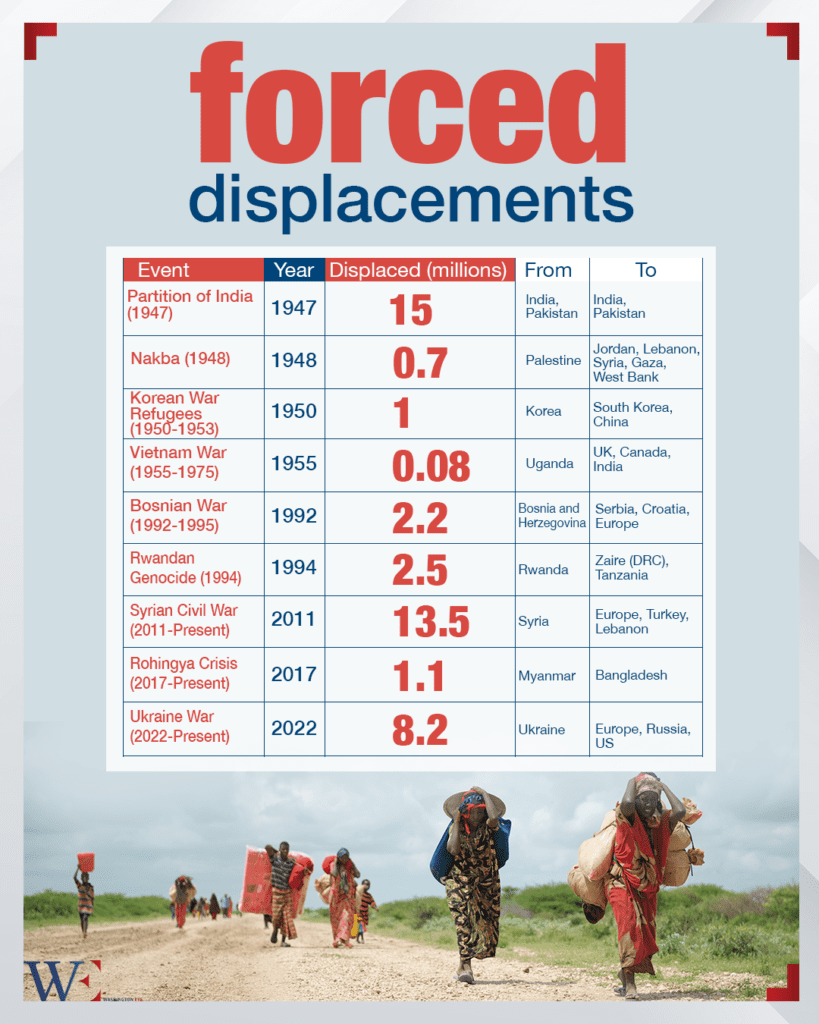The Right of Return remains one of the most contentious issues in the Israeli-Palestinian conflict, enshrined in international law yet politically obstructed for decades. For Palestinians, it is a fundamental demand tied to their displacement during the 1948 Arab-Israeli War, which resulted in the forced expulsion of approximately 700,000 people from what became the State of Israel.
Today, the descendants of these refugees, particularly in Gaza, continue to advocate for their right to return to ancestral lands. However, recent geopolitical developments, including a controversial proposal by U.S. President Donald Trump, have further complicated the discourse around this issue.
The Palestinian Right of Return is based on multiple international legal instruments, including the Universal Declaration of Human Rights (1948), which states that everyone has the right to return to their country. Additionally, the International Covenant on Civil and Political Rights (1966) affirms that no one shall be arbitrarily deprived of their right to enter their own country.
However, the most specific and frequently cited legal foundation is the United Nations General Assembly Resolution 194, passed in 1948, which states that Palestinian refugees “wishing to return to their homes and live at peace with their neighbors should be permitted to do so at the earliest practicable date.”
Despite these legal affirmations, Israel has continuously opposed the mass return of Palestinian refugees, citing concerns over demographic shifts and security risks.
The Gaza Strip serves as a focal point of the Right of Return debate. Of its approximately 2.2 million residents, nearly 70 percent are registered refugees, many tracing their roots to areas such as Jaffa, Beersheba, and Ashkelon. However, decades of blockade, political instability, and periodic conflicts have left Gaza in a state of economic and humanitarian crisis.
The blockade imposed by Israel and Egypt since 2007, following Hamas’s rise to power, has severely restricted movement, leading to high unemployment and deteriorating living conditions.
For Gazans, the Right of Return is not only a political demand but also an economic and humanitarian necessity.
Recent developments have exacerbated these tensions, particularly U.S. President Donald Trump’s proposal regarding Gaza. On February 4, 2025, Trump met with Israeli Prime Minister Benjamin Netanyahu, where he suggested that the United States should assume long-term control of Gaza and redevelop it after relocating its Palestinian population.
During a press conference, Trump stated, “The US will take over the Gaza Strip, and we will do a job with it too,” envisioning it as the “Riviera of the Middle East.”
This proposal implied the permanent displacement of Gaza’s Palestinian residents to neighboring countries such as Egypt and Jordan. Furthermore, Trump did not rule out the deployment of U.S. troops to facilitate reconstruction efforts, claiming economic prosperity could be achieved through American oversight.
Trump’s proposal was met with widespread rejection from Arab nations and international human rights organizations. Egypt, Jordan, Saudi Arabia, the United Arab Emirates, Qatar, and the Palestinian Authority all denounced the idea of relocating Palestinians from Gaza.
Egyptian President Abdel Fattah el-Sisi explicitly rejected the proposal, asserting that Palestinians should remain on their land and that any forced migration would destabilize the region. Jordan also issued a strong rebuke, reaffirming that Palestinian self-determination should be the priority, not external intervention.
Meanwhile, human rights organizations described the plan as a form of ethnic cleansing, emphasizing that forced displacement violates international law and fundamental human rights principles.
Political analysts have also criticized the proposal, highlighting its impracticality and potential ramifications. Experts noted that previous attempts to alter the demographics of conflict zones have led to prolonged instability and suffering. The forced migration of Palestinians from Gaza would not only be logistically challenging but would also fuel further resentment and resistance.
Many critics pointed to historical precedents, such as the partition of India in 1947, which led to one of the largest mass migrations in history, accompanied by widespread violence. Similarly, the Bosnian War in the 1990s saw ethnic cleansing campaigns that resulted in deep-seated regional instability.
These cases demonstrate that forced relocations rarely lead to peace or stability but rather sow the seeds for future conflicts.
The implications of Trump’s proposal directly challenge the Palestinian Right of Return. By suggesting that Gaza’s residents be permanently relocated, the plan effectively negates the possibility of refugees returning to their ancestral homes in what is now Israel. This directly contradicts international agreements that recognize the right of displaced persons to return home.
Furthermore, the proposal undermines ongoing peace efforts by introducing an entirely new and controversial element to an already fragile geopolitical landscape. If powerful nations can unilaterally decide to relocate populations and assume control of territories, it sets a dangerous precedent for international law and sovereignty.
Netanyahu, while initially cautious in his response, later signaled interest in discussing long-term plans for Gaza’s governance. While Israel has no formal claim to permanently annex Gaza, Netanyahu’s administration has sought to maintain control over its security and border policies.
Trump’s proposal aligns with Netanyahu’s broader strategy of ensuring that Gaza remains separate from the West Bank, a division that weakens Palestinian national aspirations. However, even within Israel, opinions on Gaza’s future remain divided, with some factions advocating for a full reoccupation and others supporting indirect control without direct administration.
Questions surrounding the Right of Return remain unresolved. Palestinian leaders, including those in the West Bank and Hamas officials in Gaza, have vowed to resist any attempts to forcibly relocate their population.
Protests have erupted in several Palestinian territories, with demonstrators condemning what they see as another attempt to erase their national identity.
The broader historical context of forced displacements provides a cautionary tale about the potential consequences of such a policy. Examples such as the expulsion of Palestinians in 1948, the displacement of Bosnians in the 1990s, and even the forced relocations seen during World War II highlight the long-term suffering and instability that arise from mass migrations.
Instead of addressing the core issue—the Palestinian Right of Return—Trump’s plan offers a drastic and highly controversial alternative that disregards Palestinian self-determination.
A sustainable solution to the Israeli-Palestinian conflict, including Gaza’s status, must prioritize inclusive dialogue, respect for international law, and a commitment to human rights. Any long-term resolution should involve meaningful negotiations between Palestinian representatives, Israeli authorities, and international mediators.
Ignoring the core grievances of the Palestinian people, particularly their historical displacement and ongoing humanitarian struggles, will only perpetuate conflict rather than resolve it.
Trump’s proposal has reignited global debates over the Right of Return, the legality of forced relocations, and the role of international actors in the Israeli-Palestinian conflict. While the plan may appeal to some factions within Israel and U.S. political circles, its widespread rejection by Arab nations, human rights organizations, and political analysts suggests it is unlikely to gain traction.
The fundamental question remains: can a just and lasting peace be achieved without addressing the Palestinian demand for the Right of Return?
Until this issue is meaningfully addressed, any proposed solution—especially one as radical as Trump’s—will likely face insurmountable opposition and risk exacerbating an already volatile situation in the Middle East.

















